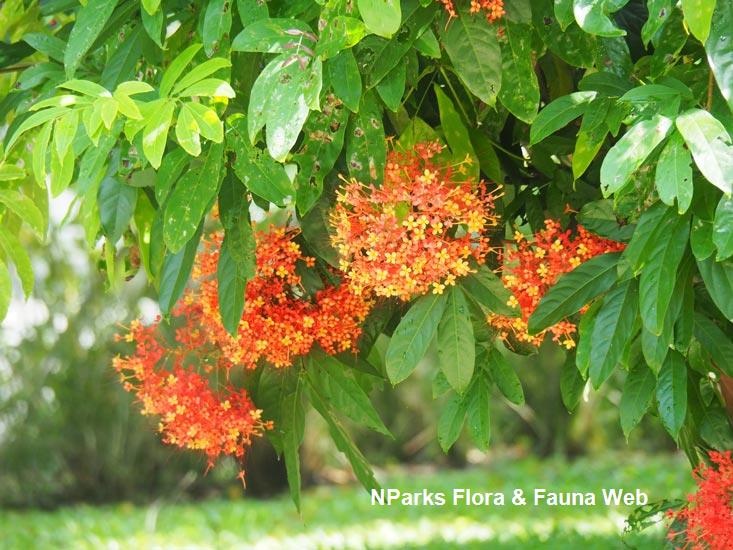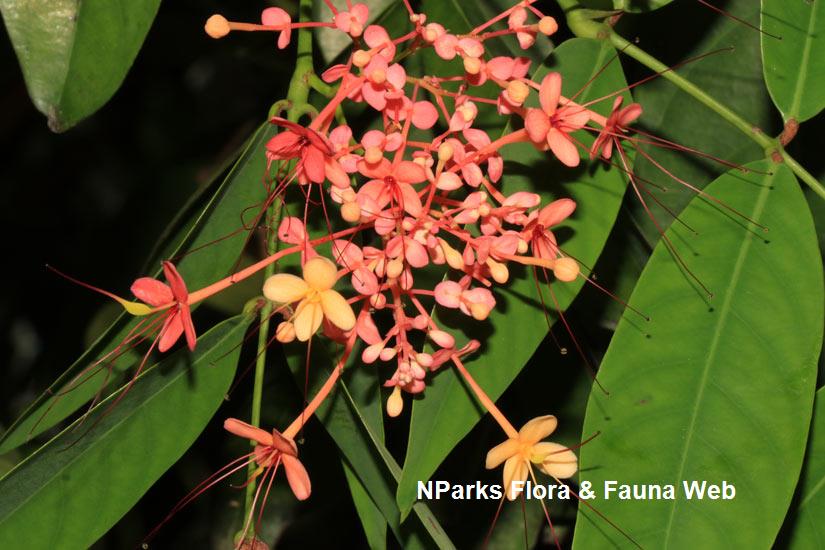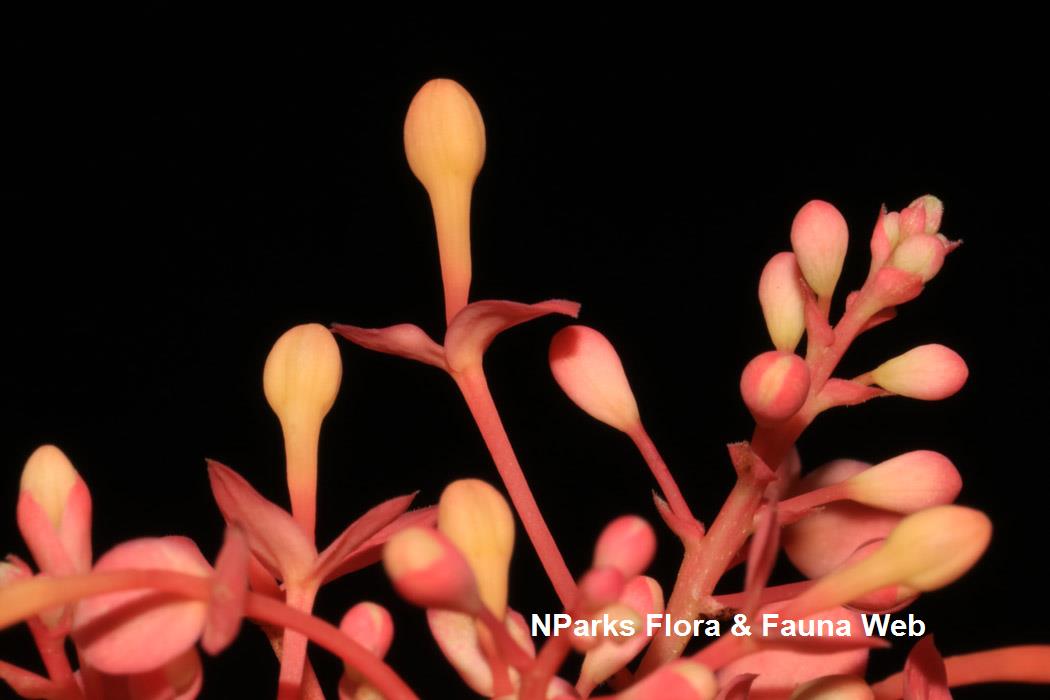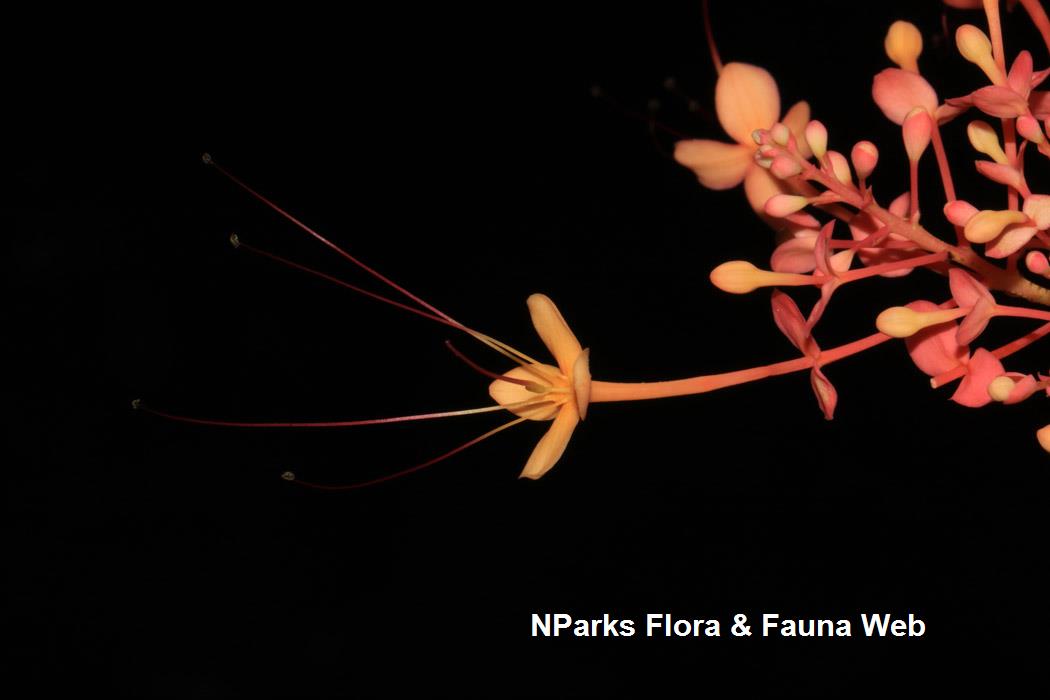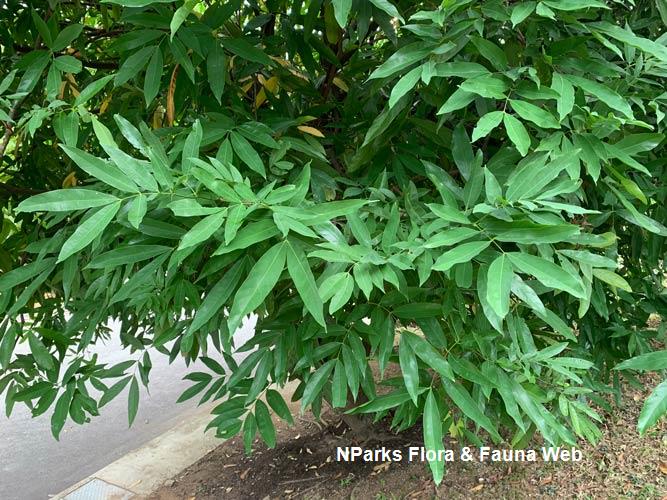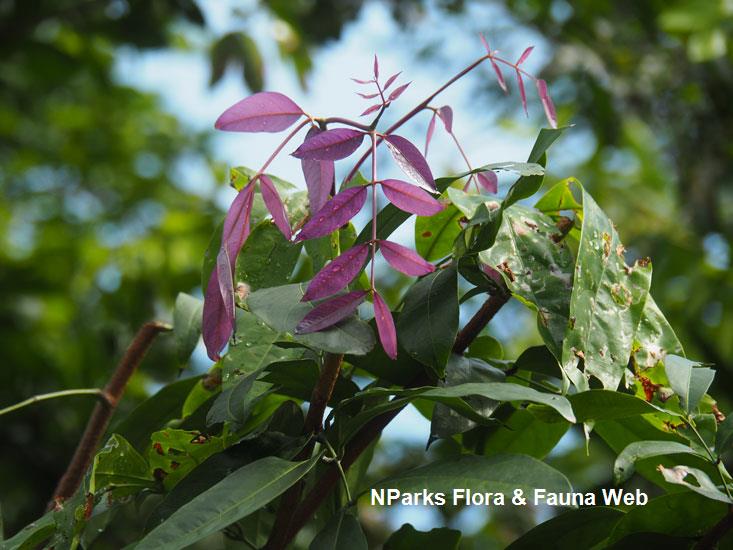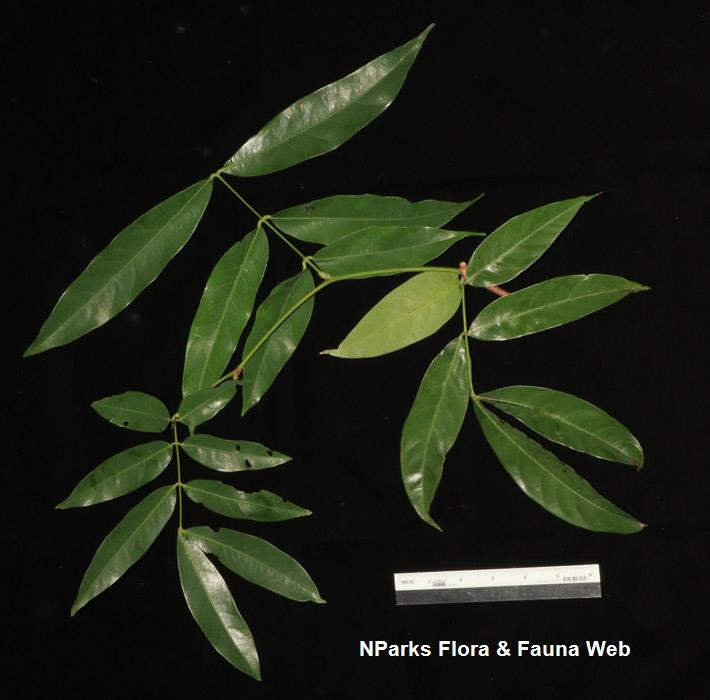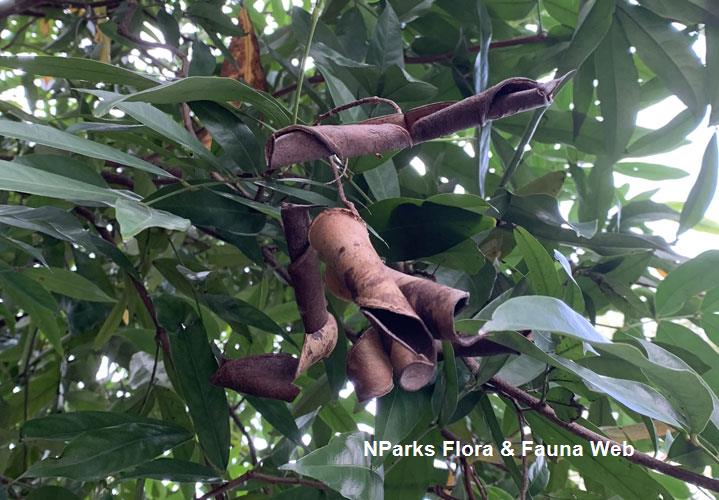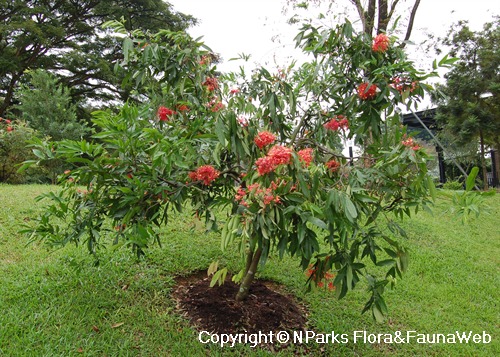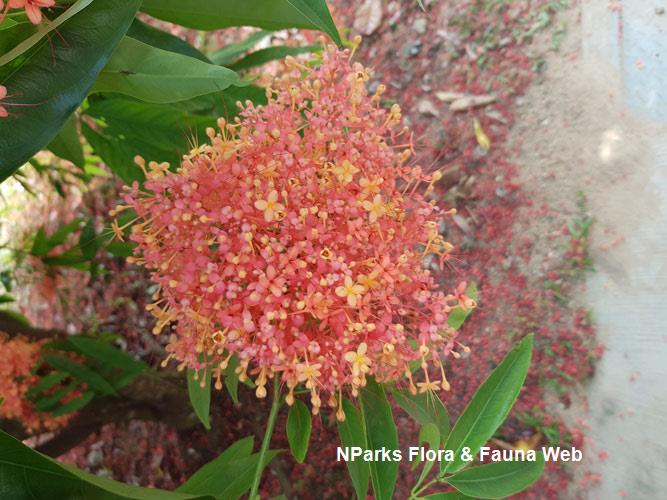
Back
Saraca declinata (Jack) Miq.
| Family Name: | Fabaceae (Leguminosae) |
| Synonyms: | Jonesia declinata Jack |
| Common Name: | Red Saraca, Gapis, Kachang Kachang, Langsat Monyet |
Saraca declinata or Red Saraca, is a tree prized for its large clusters of colourful flowers which bloom several times a year. The colours of the flowers vary widely, ranging from yellow to red, and they emit a subtle fragrance. Found naturally in rainforests along streams and rivers, it thrives in cultivation when grown under full sunlight and fertile, well-drained soil.
Name
Classifications and Characteristics
| Plant Division | Angiosperms (Flowering Seed Plants) (Dicotyledon) |
|---|---|
| Plant Growth Form | Tree |
| Lifespan (in Singapore) | Perennial |
| Mode of Nutrition | Autotrophic |
| Maximum Height | 30 m |
Biogeography
| Native Distribution | Myanmar, Vietnam, Laos, Thailand, Cambodia, Malaysia, Indonesia and Borneo. |
|---|---|
| Native Habitat | Terrestrial |
| Preferred Climate Zone | Tropical |
| Local Conservation Status | Non-native |
Description and Ethnobotany
| Growth Form | It is a tree, sometimes 3 – 6 m tall but it can grow up to 30 m tall and 60 cm diameter. Buttresses are very small. |
|---|---|
| Foliage | Leaf is 10 – 75 cm long and has (1–)3–5(–7) pairs of leaflets. Each leaflet is elliptic-lanceolate, lanceolate, or oblanceolate, about 4 – 30 (-50) cm long and 1.5 – 11 (-20) cm wide. Each leaflet has 6 – 12 pairs of lateral veins. The pair of uppermost leaflets are the largest while the pair of leaflets closest to the base of leaf often clasp twig. Leaflets turn pale brown or greenish, rarely blackish brown when dry. |
| Flowers | Inflorescence is branched (corymb), measuring up to 15(– 30) cm wide, and usually comprises of a blend of various colours simultaneously. The flower’s colour is variable, ranging from yellow, orange-pink and red, and may have a darker eye in the center. Each flower is accompanied by a showy and spreading bracteoles (0.4 – 2 cm long) which can persist but may also be deciduous sometimes. The flower stalk spans about 1 – 1.5 (–3.5) cm long. Each flower has (3 –) 4 (– 5) stamens and hairless filaments. The flowers emit a subtle fragrance and observed to bloom several times a year in Singapore. |
| Fruit | The woody fruit pod is oblong or lanceolate (about 7 – 31 cm long and 3 – 7 cm wide) with a beaked tip (about 1 cm long). Fruit pods coil and split open when ripe. Each fruit pod contains 6 – 8 seeds inside. |
| Habitat | It is found in rainforests, along rivers and streams, swamp forests, hill slopes and occasionally on slopes of limestone hills, up to 800 m altitude. |
| Associated Fauna | Flowers are pollinated by insects. |
| Etymology | The genus epithet is derived from the Indian Sanskrit name Asoka. The specific epithet, in Latin, means bent or curved downwards, possibly referring to the drooping branches. |
| Ethnobotanical Uses | Timber & Products: The wood is sometimes used to make knife handles. Cut - Dried Flower: In Laos, the flowers are used in religious worship. <4> Others: It is commonly cultivated in Singapore for its ornamental flowers. In Thailand and Laos, the flowers and seeds are eaten by indigenous villagers. <5,6> |
Landscaping Features
| Landscaping | It is commonly cultivated in Singapore for its ornamental flowers. |
|---|---|
| Desirable Plant Features | Ornamental Flowers |
| Landscape Uses | Parks & Gardens |
Fauna, Pollination and Dispersal
| Fauna Pollination Dispersal Associated Fauna | Bee-Attracting |
|---|---|
| Pollination Method(s) | Biotic (Fauna) |
Plant Care and Propagation
| Light Preference | Full Sun |
|---|---|
| Water Preference | Moderate Water |
| Plant Growth Rate | Moderate |
Foliar
| Mature Foliage Colour(s) | Green |
|---|---|
| Mature Foliage Texture(s) | Smooth, Glossy / Shiny |
| Foliar Type | Compound |
| Foliar Venation | Pinnate / Net |
| Leaf Area Index (LAI) for Green Plot Ratio | 3.0 (Tree - Intermediate Canopy) |
| Prominent Young Flush Colour(s) Remarks | Purplish-Red, Pink, Light Green |
Non - Foliar and Storage
| Trunk Type (Non Palm) | Woody |
|---|---|
| Root Type | Underground |
Floral (Angiosperm)
| Flower Colour(s) | Orange, Pink, Red, Yellow / Golden |
|---|---|
| Flower Grouping | Cluster / Inflorescence |
| Inflorescence Type | Compound Corymb |
| Flowering Period | A Few Times Yearly |
| Flowering Habit | Polycarpic |
Fruit, Seed and Spore
| Fruit Type | Dehiscent Dry Fruit |
| Seed Quantity Per Fruit | Moderate (6-10) |
|---|
References
| References | <1> Ding, Hou., Leiden, K., Larsen, K. & Larsen, S.S. (1996). Caesalpinioideae (Leguminosae-Caesalpinioideae). Flora Malesiana Series 1 Vol 12 (2) pg 409 – 730. <2> Ding, Hou. (2000). Leguminosae-Caesalpinioideae. In: Soepadmo, E. & Saw L.G. (eds) Tree Flora of Sabah Sarawak, vol. 3, pp. 119 – 180. Malaysia: Sabah Forestry Department, Forest Research Institute Malaysia, & Sarawak Forestry Department. <3> Larsen, K., Larsen, S.S., and Vidal, J.E. (1984). Leguminosae–Caesalpinioideae. In: Smitinand, T. & Larsen, K. (eds) Flora of Thailand. Vol. 4 (1), pp. 1 – 129. Bangkok: The Forest Herbarium, Royal Forest Department. <4> Pha Tad Ke Botanical Garden (2024). Saraca declinata. https://www.pha-tad-ke.com/plant/saraca-declinata/. Accessed 28 March 2024. <5> Vilayleck, E. (2013). Botanica of Laos: The Vegetables-Flowers of Laos. Pha Tad Ke Botanical Garden Newsletter Nr. 9: 10 – 19. <6> Zuijderhoudt, G.F.P. (1967). A revision of the genus Saraca L. (Leguminnosae – Caesalpiniaceae). Blumea 15 (2): 413 – 425. |
|---|
Image Repository
Others
| Master ID | 1819 |
|---|---|
| Species ID | 3112 |
| Flora Disclaimer | The information in this website has been compiled from reliable sources, such as reference works on medicinal plants. It is not a substitute for medical advice or treatment and NParks does not purport to provide any medical advice. Readers should always consult his/her physician before using or consuming a plant for medicinal purposes. |

